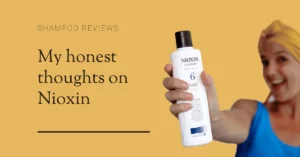
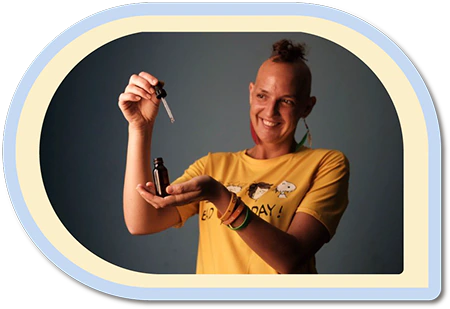
As someone who’s had alopecia for most of her life, I’ve tried A LOT of treatments for hair loss.
Including whatever chemicals I could get my hands on: the worse they smelled, the more they stung, the more I thought they worked for hair growth.
I used Minoxidil until horrible headaches made me stop. I even got corticosteroid injections – ouch. But then I realized how effective the natural approach could be, and started searching, among other products like more natural shampoos, for the best oil for hair growth.
Keep reading to discover some of the best ingredients for thinning hair and hair growth, the brands that make high-quality, pure hair growth oils, plus how you can make your own salon-worthy hair oil treatments at home.

The best hair growth oils I review in this post all offer something different – and some hair growth oils work better than others, depending on your hair type. (Which is why I recommend trying them all out!)
But each hair growth oil shares a few key benefits.
Research shows that a variety of nut and vegetable oils, like coconut, sun flower oil and olive oil, can promote better hair health.
One 2015 study showed that the linoleic acid contained in certain oils reduced the formation of split ends in the hair and the likeliness of hair breakage.
Another study showed how it can reduce DHT at hair follicles, the hormone commonly linked to thinning hair and hair loss, while even boosting hair density.
Avocado oil, jojoba, olive, almond and sesame oil are just a few more types of scalp hair strengthening oil that deeply moisturize dry or frizzy hair, improving its texture, strength, hair density and shine. Plus, fatty acids within each scalp oil moisturize your hair far better than any conditioner, while forming a protective layer against environmental damage.
That’s why a good hair serum will include a reasonable dose of these oils: I love this multi peptide serum called Gro Hair Serum from Vegamour!
The best hair growth oil starts with the scalp: nourishing each hair follicle there to support hair growth from the root.
Because to promote long, strong and thick hair growth, you need to create a healthy foundation first. The scalp is the gateway to healthy hair, after all, and many hair growth treatments ignore this fact – with products that irritate and inflame it, causing further hair concerns.
The great thing about a natural oil growth oil is, it’s kind to the scalp – even as it works to clean up excess sebum and debris, unblocking each pore and hair follicle, the scalp oil does so in a gentle way. How nice.
Plus, unless you happen to be allergic to any of the oils’ natural ingredients (which is rare), there are none of the negative side effects that you might get with more chemical-heavy hair growth products.
Basically, a good hair growth oil starts by nourishing a damaged scalp environment with essential fatty acids. Once the scalp is happy and healthy, it’ll be more likely to retain the hair you’ve got: increasing hair density and allowing new hair to take root.
The best hair growth oils are antibacterial, meaning they contain elements that ward off unwanted bacteria and offer immune support.
Since hair loss is often triggered at hair follicles by an inflammatory response to what the immune system deems as foreign invaders, anything you can do to keep the immune system in check with your hair growth treatment is A Good Thing.
Many of the hair oils on this list – particularly, peppermint and castor scalp oil – boost microcirculation to the scalp, allowing blood to reach the scalp faster and even widening vessels to improve blood flow and encourage hair growth.
It’s all part of using your hair treatment to create a healthy scalp environment, giving dormant follicles a wake-up call to promote growth and hair density.
Now that you know how the best oil for hair growth works, it’s time to look at my favorite types of hair growth oils, and hair growth brands, in more detail.
Feel free to read these hair treatment summaries or, if you want more info, check out the longer posts I’ve written about each type of hair growth oil and how they can promote healthier hair in general.
Hailing from Morocco, the kernels of the argan tree are like gold dust in the beauty industry. Why? Well, because the oil they’re pressed into, through a traditional and labor-intensive extraction method, is SO beneficial for the skin and hair that it’s called “liquid gold”.
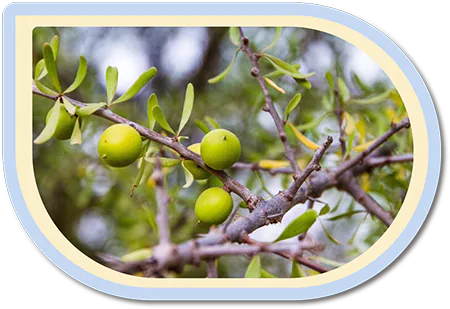
With a huge amount of Vitamin E and antioxidants known as tocotrienols to combat oxidative stress, argan oil is one of the most moisturizing, nourishing treatments you can get your hands on.
It’s amazing for giving your mane a healthy shine, for boosting thicker hair and for treating any dry scalp conditions like seborrheic dermatitis and dandruff, too.
Use it as a carrier with a pure oil like peppermint or rosemary oil to further promote hair growth. Use it sparingly though – some versions can leave hair greasy or hair oily.
Read my full review on the wonders of Argan for hair right here.
Hugely moisturizing, offers healthier hair with no harmful side effects
The most expensive natural hair growth oil on this list, due to its relative rarity
Moroccanoil – An amazing scalp hair strengthening oil that customers adore and which doesn’t leave hair greasy, unlike many hair growth oils. Check out my review on Moracconoil for more!
This is one of the most well-known natural treatments for hair loss and hair growth out there. Before all the fancy brands and the new “miracle” regrowth treatments, there was castor oil.
It’s what I used when my bald patches expanded and also what I would use on my remaining hair (which tended to get dry and brittle), whenever I needed some extra moisture.
Pressed from the beans of a tropical African plant, castor oil can be classified into Jamaican Black Castor Oil (JBCO), cold-pressed or hydrogenated – each with separate benefits.
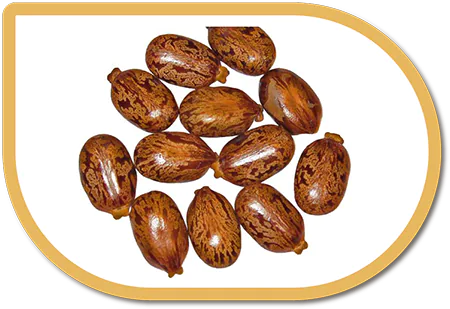
All three types are antifungal and deeply moisturizing, with a monounsaturated fatty acid called ricinoleic acid.
This makes castor oil a popular choice as a base for hair growth and skincare products (customers especially love it for boosting eyebrow/eyelash growth) and it’s one of my personal favorites to create hair masques or leave-in conditioners.
Read my full review about castor oil for hair growth here.
Excellent base to create your own hair care and other beauty products.
It’s quite a thick hair growth oil, which in some cases can mat or tangle the hair, or leave the hair feeling greasy.
Pura D’Or – who make lots of great hair thinning and hair growth treatments, read more about the brand in this post!
Probably the most versatile oil on this list, you can use coconut as an oil for cooking, to whiten your teeth, to moisturize skin and nails and of course, to improve the quality and thickness of your hair as a hair growth oil.
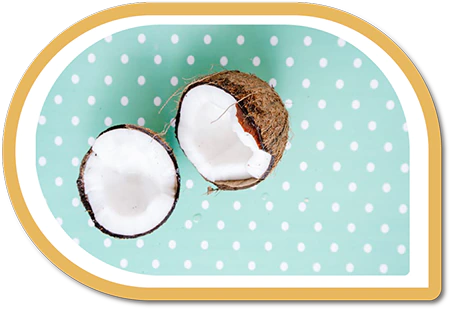
I used to love using this oil instead of a conditioner; back when I had hair, I’d run a little organic coconut oil through my dry ends.
But then I started using it nearly every night (combined with peppermint oil) as an intensive hair masque treatment, too. I noticed that when I did this consistently, a little white fuzz would form on my bald patches… so it seemed to work pretty quickly to promote hair growth!
Rich in Vitamin E, coconut is also known for its antimicrobial and hormone-balancing properties – good news if you’ve got a condition like alopecia, which can be triggered by bacteria and hormone imbalances.
There’s really no downside to using this nutty oil to promote hair growth or for maintaining healthy hair – it moisturizes the hair, it soothes the scalp and it smells like holidays! Yum.
Read my full post on coconut for hair growth here.
Brilliant for hair health plus a range of other applications. Get a good-quality hair growth oil and you can use it for all of your beauty (and culinary) needs!
There are lots of cheap options out there that are much more processed. Avoid.
Like argan, neem oil is many a beauty expert’s secret weapon – and for good reason. In India, the tree that produces neem fruits is known as “the village pharmacy”, thanks to its all-healing properties.
And if you aren’t as familiar with this golden-yellow scalp hair strengthening oil as the others on this list, it’s time you got acquainted with neem as a hair growth oil!
Because neem seed oil, in addition to having miraculous wrinkle-diminishing and scar-vanishing qualities, is AMAZING for your scalp and hair. This is largely due to its active ingredient called nimbidin, which suppresses inflammation, plus to a bunch of nourishing fatty acids and antioxidants to restore damaged hair.
And although people aren’t crazy about its smell, they are crazy about everything else!
To learn more about neem oil for hair growth, have a read of my full review.
One of the best hair growth oils for nourishing a dry scalp, promoting healthy hair and improving skin quality in general.
The smell. Some reviews describe their hair growth oil as “nutty”, others as “strong roasted garlic”. So maybe one to try out indoors…
A small and mighty bottle of PEO is never far away from my grasp! I use it to soothe headaches, to add a minty kick to a hot chocolate and yes, even to boost hair growth.
I knew from reading the ingredients of many top hair-growth brands that pure peppermint must have more going for it than simply smelling fresh. So I started introducing the pure stuff into my own hair care – mixing it with either jojoba oil, castor oil or coconut and applying it as a leave-in treatment on either dry hair or towel-dried hair.
The hair growth results were really effective and since researching PEO further, finding that in animal trials it’s actually better than Minoxidil, I have even more faith in it as a natural hair loss remedy.
Combined with a good carrier oil, and perhaps even mixed with a couple of drops of rosemary oil for a further boost of blood flow, PEO could very well be the best oil for hair loss and regrowth.
For more on the many benefits of this minty oil for thin hair and hair growth, read my full post.
Proven to boost blood circulation and improve oxygen levels to the scalp, providing a much healthier environment for new hair growth. Also, a couple of drops go a long way!
Needs to be mixed with a hair strengthening oil, like a carrier, as the pure stuff is too strong by itself.
Which oil is best for hair growth? Well, it depends on a range of factors. Here are just a few things to bear in mind when shopping for hair oils…
What works for my hair growth may not work for you. For instance, those with dense or curly hair often rave about castor oil while those with thin hair or fine, thinning hair might prefer lighter hair oils, like Moroccanoil Light Treatment.
Your dream hair growth oil may also depend on your budget. Although most hair growth oils are affordable, argan and neem hair oils are are a bit more expensive, thanks to higher sourcing and transport costs.
In all cases, the purer the hair oil, the better. Many hair growth products will boast that they have argan oil in their ingredients list… but that doesn’t mean it’s this hair oil is the real deal.
Readymade shampoos and conditioners, like Lipogaine’s Big 5, are a handy way to bring these natural ingredients to your scalp. But the very best way is to buy 100% pure, organic hair oil.
If you’re looking for a good all-rounder oil – one you can use for cooking, skincare and as a hair oil – then coconut is a good option. Peppermint oil has plenty of therapeutic benefits. While neem oil can also be used in gardening for pest control!
Many of these oils serve a variety of functions but the good news is, they’re all good as a hair oil.
Unfortunately, as popularity for natural oils increases, so too do companies out to make a quick buck with substandard products. So do your research on the hair oil before you buy (have a look at those full posts I’ve linked to above for help!)
Check that the hair oil you’re looking at has the color and smell it’s meant to, that it’s kept in a dark glass bottle (in the case of argan oil) and that the method of extraction is as unprocessed as possible – for instance, cold-pressed.
You’ve chosen the type of hair oil you want, you’ve selected your brand of choice and your product has arrived. Great. Now what?!
Well, you can apply pretty much all of these oils (apart from peppermint) in one of three ways:
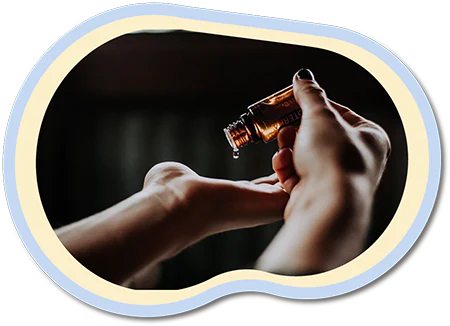
Before I get into some handy hair mask recipes, I want to flag two other types of hair oil that help to reduce hair thinning, stimulate hair growth and nourish the hair shaft. I’ve already mentioned them elsewhere in this post but just to give a little more detail…
These are oils that you use as a base for pure, essential oils (which are often too strong to apply directly to the skin). They come from nuts or seeds and use methods of extraction (like cold-pressing) to retain maximum nutrients for scalp health, repair damaged hair from oxidative stress and promote healthy hair growth.
Your carrier can be a single hair oil, like castor oil, sweet almond oil or jojoba, but for even more hair growth opportunities, try mixing a few together. In terms of brands, I love Pura D’Or oils for both carrier oils and essential ones!
So, I’ve already included peppermint essential oil (PEO) on this list, And I’ll do a separate post on some other essential oils I recommend for hair growth soon. Rosemary oil and tea tree oil are great choices, too.
All you need to know for now is that essential oils like peppermint and rosemary oil are one of the purest ways to stimulate hair growth, among a range of other health benefits. Whether you choose to diffuse them, smell them or use them for massages, these are amazing additions to your self-care and hair-care routines!
Since they’re more concentrated than carrier oils (they’re distilled directly from plants), you’ll usually need to dilute them to avoid skin irritation.
I love hair serums that include pure essential oils, like Gro hair serum from Vegamour. One of the only serums that actually brought healthy hair growth back to my scalp, you can read about Gro Hair Serum for hair density in this review.
I promised I’d share some salon-worthy thinning hair treatments, didn’t I? Well, I won’t disappoint! Here we go: 3 of Lady Alopecia’s favorite DIY hair masks, starring my top oils from this post.
Ingredients
Method
Ingredients
Method
Ingredients
* Made of: 15ml coconut, 15ml jojoba oil and 20ml grape seed oil.
Method
Yes, apart from peppermint, all of these hair growth oils are fine for topical application. You’ll need to mix PEO with a carrier.
Most of them do, yes! At least, argan, castor and neem all have… let’s just say, pungent aromas! Hey, that’s what you get for the gifts of Mother Nature!
The brands I’ve mentioned are all available on Amazon. But if you prefer, you can check out your favorite beauty supplier, in-store or online for a decent hair growth oil. Just make sure to consult the Buyer’s Guide I shared before you make your choice!
I would recommend you do so, yes! For instance, I’ll use castor oil for a couple of days in a row, then I’ll switch to a mix of coconut and peppermint oil. Variety is the spice of life, after all! Alternatively, you might want to try them all out and see which is the best hair growth oil for you, then stick to it.
In this post, I’ve shared some of my best oils for hair loss and thinning hair, what makes them so special and how different hair types can use them to improve hair regrowth. Feel free to read the expanded posts on each hair growth oil or, if you feel like you have enough info to go on, get shopping!
In my own experience, the best hair growth oil is neem oil mixed with a couple of drops of peppermint. Another fellow alopecian, new to this site, told me her best hair growth oil was “Rosemary Mint Scalp”: coconut mixed with peppermint and rosemary oil. See, it might be different for everyone!
So try the oils out and let me know how you get on! Oh, and if there’s a type of oil you love using for your noggin which I haven’t reviewed yet, feel free to share your best hair growth oil it in the comments below.
Love & hugs,
Get free, semi-regular alopecia-related news things and musings.
Psst… If no welcome email shows up, check your spam.
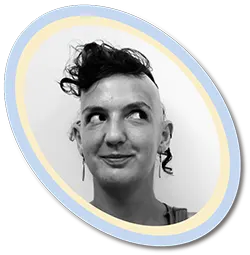
Alopecian. Yoga Teacher. Copywriter. Here to share information, offer support and show people the adventures that can lie in hair loss. I’m proud to have alopecia and I want to help others embrace their baldness, too!

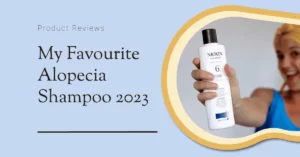
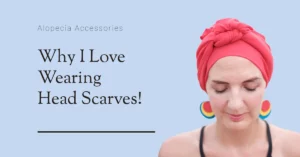
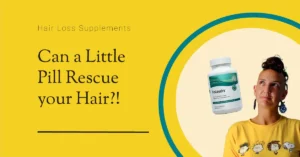

Every month, thousands with hair woes visit my site. The more the merrier! But it takes AGES to write posts and reply to emails. Don’t get me wrong, I love it! But running a website isn’t free. So I’m trying something new: I’m asking for your support. If Lady Alopecia has helped you, please consider buying me a (virtual) coffee or even become a patron of the site. Thanks!
I’m Emma. I’ve had alopecia for 24 years and I’m here to inform/hopefully empower people like me! Read my full story here. But I’m not a doctor, so any advice here is based on my own research and experience. I’m also in a few affiliate programs – see my disclaimer page for more. Or contact me here. Also, why not join a thousand fellow alopecians and get my-semi regular hair about life with irregular hair?
Psst… If no welcome email shows up, check your spam.
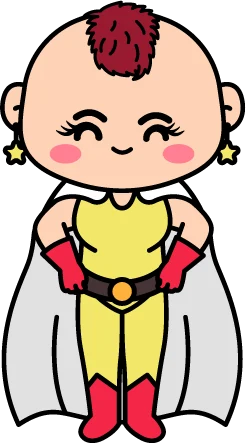
Small print time: Ladyalopecia.com is a participant in the Amazon Services LLC Associates Program, an affiliate program designed to provide a means for sites to earn advertising fees by advertising and linking to Amazon.com.
Copyright © 2023, Lady Alopecia. All rights reserved. Important – By using this website, you promise not to steal stuff. Thank you kindly.
Just stick in your email to join the gang.
If no welcome email appears, please check your spam. Oh, and don’t worry, I won’t give your details to Zuckerberg and you are free to unsubscribe at any time.
Join the gang and receive semi-regular news and joy from someone with very irregular hair.
12 responses
Hi, my name is Melissa. I do not have alopecia, but my son started going bald in his 20s I didn’t know anything about alopecia, especially in men. In 2022 I found out that alopecia was worldwide, I began to notice it in my race especially during /after COVID-19, and I also was dealing with my hair issue, so I decided to do something about it and start my own hair growth oil business I am excited about my journey Is there any pointer, and how effective are these particular oils. I applied and waiting for my paper work to arrive for my LlC. Thank you for listening
Thanks for sharing Melissa, and wishing you all the best with your new venture! Take care 🙂
I have been dealing with my hair loss journey for about two years now. My dermatologist originally thought I had telogen effluvium from Covid. But two years later I am starting to get bald spots. Recently I started looking into underlying causes and am thinking I may have high Dihydrotestosterone (DHT). Have you ever done research or looked into this? Right now I’m looking at changing my diet to lower these levels because I heard it could help with the hair loss. I do have an appointment with my doctor scheduled for some more testing but if i can get a jump start on this I would love to
Hi Amanda, I’m really sorry to hear about your hair loss. And your dermatologist may have been right, it could have been triggered by COVID (there’s a real connection between the two, yes, telogen effluvium but other forms, too). Since there are multiple factors involved in hair loss, perhaps Covid was the thing that triggered the hormonal imbalance in the first place.
DHT is indeed a factor in hair loss, particularly around male pattern baldness (androgenetic alopecia). And some of the shampoos I mention on this list or certain supplements will inhibit DHT production for that reason. But it’s worth checking your hormone levels just to be sure, rather than forking out on treatments you may not need.
You’re right, gut microbiome issues are another big trigger, I’ve written about that here: http://www.ladyalopecia.com/gut-health-and-hair-loss/
I hope your doctor’s appointment proved helpful and that you’re finding ways to manage your hair losss…but it sounds like you’re on the right track!
Wishing you all the very best,
Emma x
Hi,
First I just want to say thank you for this website. I just got diagnosed with alopecia areata and it’s been a real help. I was wondering how often do you do your hair oil treatments? And how often do you wash your hair?
Hi Emily, thanks so much for your kind feedback…and I’m really sorry to hear about your recent diagnosis. I know from experience how tough AA is, especially when you’re watching every second to see whether the patches have spread further! (If that sounds familiar, check out this post!) In response to your question, honestly I don’t use the oil treatments half as much as I should – as a new mum, I tend to be pretty forgetful these days! But all of them are recommended for daily use, some can even be used twice a day. For instance, if using coconut, neem or argan, you can mix with a little peppermint oil (rosemary’s great, too) and rub it in as a massage either before you go to bed or even before your morning shower, too. In that case you’d want to wash your hair daily so it doesn’t get too oily. If using castor oil, it’s much thicker so once or twice a week as a deep mask treatment might work better for you.
Personally I wash my hair daily – but there’s not much hair left, admittedly! It really depends on what kind of hair you have, and how it responds to the oils. Maybe start with something quite light (like a mix of coconut oil and peppermint) and apply it at night, leave it in, then wash your hair in the morning. After a few weeks, you might like something a little thicker, like argan oil. See what works for you!
I hope that helps, Emily…and wishing you all the very best!
Emma / Lady Alopecia xo
I have heard good things about Rosemary oil for hair regrowth. What are your thoughts?
Yes, great question! I’ve used a mixture of it and peppermint in the past, or you can use them interchangably. Rosemary is a really popular natural remedy as it boosts circulation like some of the others on this list…plus it’s very grounding if you’re feeling anxious. Just make sure the one you use is USDA certified and pure organic essential oil! I love Doterra but Pura D’Or do a version also. Thanks, Bonnie!
All of a sudden my hair started falling out. Went to the doctor and yes it’s alopecia. Just doing research and found your website I have been able to Chang my mindset. Thank you 🙏
Hi Marie,
Thanks for your lovely comment and big apologies for the late reply – I just had my first baby so had taken a little break! I’m so sorry to hear about your diagnosis, it’s such a frustrating/scary thing to hear. I’m glad my site has been helpful to you in your journey so far, especially in that mindset shift! Please feel free to join my free newsletter if you’d like to be updated with the latest inspirational tidbits!
Take good care,
Emma / Lady ALopecia xxx
Have you tried Bhringraj?
Hi Suzi, oh I haven’t actually! But I see it’s a member of the sunflower family, and I do love sunflowers!! 😉 Have you seen success with it? I’ll see if I can source some in Vietnam and try it out!